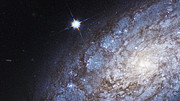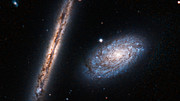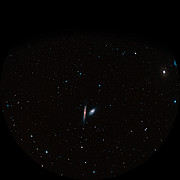This illustration shows the galactic orbit (grey dots) of a star cluster (with 800 solar masses) that formed in a dwarf galaxy. The insets show individual cluster stars at three different times in the life-cycle of the star cluster: when the compact cluster has formed (red); after 50 Myr (half an orbit, green); and after 450 Myr (several orbits, blue), when the cluster is almost entirely disrupted. The background shows stars which have formed in the last 500 Myr (see movie below for details). © MPA
Most stars form in clusters, deeply embedded in the densest and coldest cores of giant molecular gas clouds. A few million years into the formation of a cluster the remaining gas is finally expelled by supernova explosions. Thereafter the clusters lose stars in the galactic tidal field and eventually disrupt. This entire life-cycle is very difficult to observe. Star clusters begin their lives deeply embedded in their birth clouds and are invisible to most observatories and the disruption of a single cluster can take tens of millions of years or more. An international team led by researchers at MPA has presented a new high-resolution supercomputer simulation, which can follow entire galactic star cluster life-cycles from birth to disruption and sheds light on the unobservable phases of star cluster evolution.
Most stars form in clusters, deeply embedded in the densest and coldest cores of giant molecular gas clouds. A few million years into the formation of a cluster the remaining gas is finally expelled by supernova explosions. Thereafter the clusters lose stars in the galactic tidal field and eventually disrupt. This entire life-cycle is very difficult to observe. Star clusters begin their lives deeply embedded in their birth clouds and are invisible to most observatories and the disruption of a single cluster can take tens of millions of years or more. An international team led by researchers at MPA has presented a new high-resolution supercomputer simulation, which can follow entire galactic star cluster life-cycles from birth to disruption and sheds light on the unobservable phases of star cluster evolution.
The complex life of star clusters
A typical young star cluster is a home to up to thousands of stars contained in a compact size of a few parsecs. The most massive ones, such as globular clusters, can exceed millions in their stellar count. Some of stars in these clusters are born with masses that exceed the mass of the Sun by tens or hundreds of times. Such massive stars are extremely rare (less than one in every 100 stars) and they live only for a few million years. They are, however, vitally important for creating new chemical elements through nuclear fusion, including those that are requisites for the formation of planets and the development of life.
Once massive stars form, they start releasing energetic photons and fast stellar winds that interact with the surrounding birth-cloud of gas. After a few million years, once the stars have exhausted their nuclear fuel, the most massive ones end their lives as explosive supernovae. These so called “feedback” processes deposit heat, momentum and heavy elements into the birth-cloud, eventually expelling the remaining gas that is left over from star formation.
This marks the transition of a young star cluster into a system that mainly evolves by gravitational interactions among its stars and with the surrounding tidal field. Through dynamical interactions, massive stars can sink to the centre of the cluster and stars can end up in binaries. Further gravitational interactions at the centre of the cluster force low mass stars on increasingly distant orbits. These stars can then become unbound and escape from the gravitational potential of the cluster into the galactic field. While orbiting in the host galaxy, the cluster continuously loses mass and ultimately disrupts entirely (Fig. 1).
Once massive stars form, they start releasing energetic photons and fast stellar winds that interact with the surrounding birth-cloud of gas. After a few million years, once the stars have exhausted their nuclear fuel, the most massive ones end their lives as explosive supernovae. These so called “feedback” processes deposit heat, momentum and heavy elements into the birth-cloud, eventually expelling the remaining gas that is left over from star formation.
This marks the transition of a young star cluster into a system that mainly evolves by gravitational interactions among its stars and with the surrounding tidal field. Through dynamical interactions, massive stars can sink to the centre of the cluster and stars can end up in binaries. Further gravitational interactions at the centre of the cluster force low mass stars on increasingly distant orbits. These stars can then become unbound and escape from the gravitational potential of the cluster into the galactic field. While orbiting in the host galaxy, the cluster continuously loses mass and ultimately disrupts entirely (Fig. 1).
More realistic star cluster simulations
Numerical simulations are an invaluable tool to probe the entire cycle of formation and disruption of star clusters on spatial and temporal scales that are inaccessible to observations (see previous Research Highlight December 2021 and Research Highlight October 2019). A recent study led by Postdoctoral Fellow Natalia Lahén at MPA presentedthe first star-by-star hydrodynamical galaxy simulations. Detailed modelling of individual stars is crucial for resolving the internal structure of star clusters. The simulation code for this project was first developed at MPA and further improved in international collaboration including researches at the University of Helsinki in Finland and Nicolaus Copernicus University in Poland. For the study presented here the team used a very accurate gravity solver to follow close gravitational interactions between stars. With this method it was possible to simulate, for the first time, the evolution of an entire dwarf galaxy with all its stars, gas and dark matter. At the same time, they could accurately follow the dynamical evolution of hundreds of individual star clusters, each containing at least hundreds or thousands of stars.
Star cluster simulation
This movie follows the evolution of a low-mass galaxy for 500 million years modelled with the new method. The panels show the surface densities of stars (top left) and interstellar gas (top right), as well as the temperature (bottom left) and thermal pressure (bottom right) of the gas. Star clusters can be seen as concentrations of stellar mass, and the leading and trailing tidal tails extending from the clusters indicate that they are losing stars and being gradually disrupted. Energetic feedback from young massive stars can be seen as bubbles and cavities in the gas distribution.
This figure shows the time evolution of the size and mass of a number of selected star clusters in the simulation. The color scale indicates the mean stellar age of the clusters and the black lines connecting the data points indicate the evolution of indiviual clusters. The clusters start embedded (triangles). They first contract and then expand once the star formation is halted and gas is removed (circles). The size evolution is compared to observed clusters in the Large and Small Magellanic clouds (green stars and crosses) and clusters in low-mass galaxies measured in the LEGUS galaxy survey (blue symbols). Even though the simulated clusters form very compact, they evolve to the observed range of sizes over ~10 million years. © MPA
This figure shows the time evolution of the size and mass of a number of selected star clusters in the simulation. The color scale indicates the mean stellar age of the clusters and the black lines connecting the data points indicate the evolution of indiviual clusters. The clusters start embedded (triangles). They first contract and then expand once the star formation is halted and gas is removed (circles). The size evolution is compared to observed clusters in the Large and Small Magellanic clouds (green stars and crosses) and clusters in low-mass galaxies measured in the LEGUS galaxy survey (blue symbols). Even though the simulated clusters form very compact, they evolve to the observed range of sizes over ~10 million years. © MPA
Star cluster evolution in a galactic context
Authors:
Natalia Lahén
Postdoc
tel: 2253
nlahen@mpa-garching.mpg.de
Antti Rantala
Postdoc
tel: 2253
anttiran@mpa-garching.mpg.de
Naab, Thorsten Naab
Scientific Staff
tel: 2295
tnaab@mpa-garching.mpg.de
Original publications
1. Natalia Lahén, Antti Rantala, Thorsten Naab, Christian Partmann, Peter H. Johansson andJessica May Hislop
The formation, evolution and disruption of star clusters with improved gravitational dynamics in simulated dwarf galaxies
Monthly Notices of the Royal Astronomical Society, 2025
DOI
2. Natalia Lahén, Thorsten Naab, Guinevere Kauffmann, Dorottya Szécsi, Jessica May Hislop, Antti Rantala, Alexandra Kozyreva, Stefanie Walch and Chia-Yu Hu
Formation of star clusters and enrichment by massive stars in simulations of low-metallicity galaxies with a fully sampled initial stellar mass function
Monthly Notices of the Royal Astronomical Society, 2023, Volume 522, Issue 2, pp.3092-3116
Source
The new high-resolution simulations of a dwarf galaxy similar to Wolf–Lundmark–Melotte (WLM) in the Local Group (see the Movie for an illustration) show how gas and stars interact through cooling, collapse, star formation, and stellar feedback. The orbits as well as the release of energy and chemically enriched material of each star are followed individually along the stellar lifetime. Thanks to the new algorithm for gravitational force computation, in particular encounters with massive stars can be followed down to stellar radii and the dynamical evolution of the clusters embedded in the galactic interstellar medium can be followed at unprecedented accuracy.
The new simulations show that initially, while they are still embedded in the birth-cloud, star clusters can form very compact (see Figs. 1 and 2). During the following ten million years their sizes increase to the observed ~1 parsec due to dynamical evolution and stellar mass loss. The new methodology and its future expansion will play a key role in the next generation of simulations that aim to probe more extreme star forming systems called starbursts. Starbursts can be induced for example by compression of gas in galactic mergers or through gaseous inflows during the early cosmic epochs when galaxies themselves were still forming. The extreme gas densities promote the formation of increasingly massive star clusters.
The next step is to use the new methods to decipher the internal chemical and kinematic structure of the most massive clusters known as globular clusters. Globular clusters are the oldest bound star clusters observed in the Milky Way, dating back to the Cosmic Dawn. Understanding their birth conditions in synergy with state-of-the art observations of high-redshift star formation (from e.g. HST and JWST) as well as the Milky Way clusters (e.g. from Gaia and the upcoming 4MOST) may thus reveal how our home galaxy first started to form.
This work was supported by Gauss Centre for Supercomputing grants pn49qi and pn72bu at the GCS Supercomputer SUPERMUC-NG at Leibniz Supercomputing Centre and the Max Planck Computing and Data Facility.
The new simulations show that initially, while they are still embedded in the birth-cloud, star clusters can form very compact (see Figs. 1 and 2). During the following ten million years their sizes increase to the observed ~1 parsec due to dynamical evolution and stellar mass loss. The new methodology and its future expansion will play a key role in the next generation of simulations that aim to probe more extreme star forming systems called starbursts. Starbursts can be induced for example by compression of gas in galactic mergers or through gaseous inflows during the early cosmic epochs when galaxies themselves were still forming. The extreme gas densities promote the formation of increasingly massive star clusters.
The next step is to use the new methods to decipher the internal chemical and kinematic structure of the most massive clusters known as globular clusters. Globular clusters are the oldest bound star clusters observed in the Milky Way, dating back to the Cosmic Dawn. Understanding their birth conditions in synergy with state-of-the art observations of high-redshift star formation (from e.g. HST and JWST) as well as the Milky Way clusters (e.g. from Gaia and the upcoming 4MOST) may thus reveal how our home galaxy first started to form.
This work was supported by Gauss Centre for Supercomputing grants pn49qi and pn72bu at the GCS Supercomputer SUPERMUC-NG at Leibniz Supercomputing Centre and the Max Planck Computing and Data Facility.
Authors:
Natalia Lahén
Postdoc
tel: 2253
nlahen@mpa-garching.mpg.de
Antti Rantala
Postdoc
tel: 2253
anttiran@mpa-garching.mpg.de
Naab, Thorsten Naab
Scientific Staff
tel: 2295
tnaab@mpa-garching.mpg.de
Original publications
1. Natalia Lahén, Antti Rantala, Thorsten Naab, Christian Partmann, Peter H. Johansson andJessica May Hislop
The formation, evolution and disruption of star clusters with improved gravitational dynamics in simulated dwarf galaxies
Monthly Notices of the Royal Astronomical Society, 2025
DOI
2. Natalia Lahén, Thorsten Naab, Guinevere Kauffmann, Dorottya Szécsi, Jessica May Hislop, Antti Rantala, Alexandra Kozyreva, Stefanie Walch and Chia-Yu Hu
Formation of star clusters and enrichment by massive stars in simulations of low-metallicity galaxies with a fully sampled initial stellar mass function
Monthly Notices of the Royal Astronomical Society, 2023, Volume 522, Issue 2, pp.3092-3116
Source









